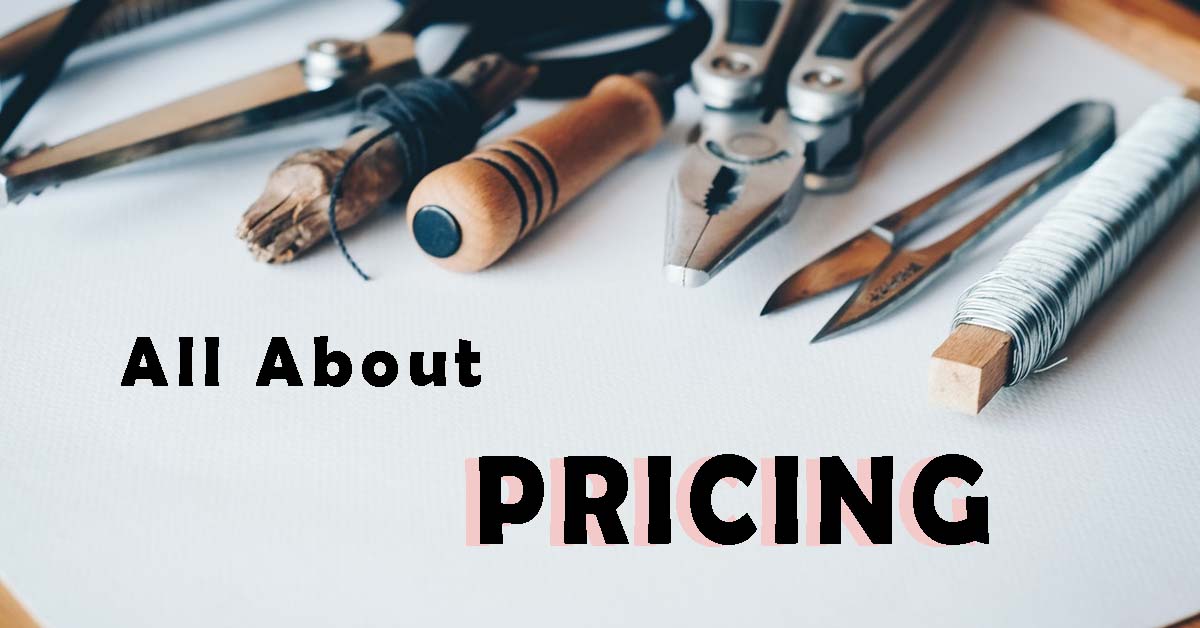One of the most important decisions you make when starting your business is deciding how you will price your products and/or services. Both types of businesses follow a similar pricing structure but have significant nuances that make them unique. Today we’ll be covering both of them and hope to help you price your products as you get ready to start your dream business this year!
Starting a business is full of learning curves for most people. It can be intimidating to tackle too many different aspects of a business as you are starting out but few are as important as your pricing. Setting your prices is one of the most important decisions for your business and your future customers. Prices play a big part in how potential customers value your business and ultimately decide to purchase, so let’s consider how you should really set your prices whether you’re a product or service based business!

Products:
As a product based business, there are a couple of different ways you can price your business; simple cost-plus where you take into account materials, labor and profit margin, competitive pricing, economic pricing, and luxury pricing. However, the key to pricing your items correctly is never based on just the numbers behind creating your products but the brand that you have created and your long term business strategy. Based on an amalgamation of research on the internet, here’s the process we’ve come up with in creating your pricing strategy as a small business or entrepreneur!
- Cost, Price, Labor, Overhead?
Yes, even as a one woman show you must take into account the overhead and labor costs of your products even if you are still making them yourself on your kitchen counter. You must consider the future of your business and how you hope to scale so that your business has a fighting chance once you actually start generating sales. To use the cost-plus strategy here, take your desired profit margin (for example 50%=.5) and multiply it by the material and labor cost of your product. Then simply plug them into this equation: Product Price = Product Cost/ (1-Target profit margin)
Does this number seem rather high to you? Believe it or not, it’s not! Typically small business owners and entrepreneurs tend to underprice their items because they focus too much on competing with businesses who can manufacture and create their products much more cheaply. Don’t start off comparing yourself to giant companies at scale, but with other small businesses in your niche. Lastly, don’t forget to count your overhead! Overhead expenses can be fixed or variable: fixed costs are those you know you will pay every month-rent, salaries, utilities etc. Variable expenses include those that vary month to month and depending on seasonal changes that fluctuate profit- include: marketing, shipping, travel, etc. Here’s a great link to a startup cost spreadsheet from the SBA!

2. Speaking of Competition…
There is a lot of competition out there! No matter what niche you enter, you can count on a couple of other businesses out there doing something very similar to you, maybe even the same thing. The key to differentiating yourself here is your branding and your strategies. This step takes a whole lot of research. Get out there and learn everything you can about your competitors, their products, their customers, their social media and pricing strategies- not to copy them but to develop your own unique strategies in response. Getting a general idea of your competitors prices can help you define your profit margin, overhead and labor expenses to keep costs on track for your profit margin. You don’t want to start a business and then wind up becoming an identical twin to a company that is already out there.
Do you want your brand to be about accessibility or exclusivity? Whatever the decision, reflect this in your pricing and your branding. Research shows that pricing your items higher than the norm ( keeping quality relatively the same) gives customers a luxury impression of your brand. While this is great for higher profit margins it can be harder to generate a sale when doing this, depending on your target market.
3. Consider the Customer
It’s no secret that the key to a successful business is sales, and sales come from customers. Market research means knowing who you want your business to appeal to; are they older, younger, female, etc. Age is actually a very important factor to consider when pricing your items. Remember that a younger demographic does not have the expendable income that working adults do. This doesn’t make selling to them impossible, but it does make it harder- you are not just selling to your customer but to their parents who will ultimately make the purchase for them. The spending power of your demographic is very important in developing your pricing strategy but don’t fret if you don’t get it right the first time. Pricing strategies vary from lowering them as you scale, to increasing them as you discover your product is more valuable than you originally thought it to be. As your brand and product changes your prices will too, so don’t drive yourself crazy trying to get the perfect price the first time.
4. You are Creating Value.
Aside from the product you are creating there is real value in everything you are doing for your business: the branding, promotion, shipping, and of course all the customer service you offer. You have to be able to show customers the real value of your product so that when it is reflected in your price, they understand. How do you do this? There are a couple of ways you can do this:
- Reframe your products value– instead of a $20 product, make clear how that $20 product is reflected in the purchase of it. Consider this example: a subscription box priced at $84/month, against an $1000/year it’s easier for a customer to see how much they can get out of an $84/month subscription (shorter term) vs. the longer term $1000/year subscription.

- Appeal to the utility and pleasure your product brings to your customer! Conservative spenders will react better to a message focusing on utility: for example: “This back massage can ease back pain.” While more liberal spenders are better persuaded by a focus on pleasure: “This back massage will help you relax.” This is where your market research will greatly come in handy, because knowing what will appeal to your customer allows you to describe your products better and target your customers correctly.
Finally, to hammer home the importance of pricing- take it from Harvard Business Review:
“Our research also suggests that consumption is driven not so much by the actual cost of a paid-for product as by its perceived cost. This perception is influenced greatly by the manner in which the product is priced. Some pricing policies highlight the perceived cost of a paid-for product while other pricing policies mask the cost.”
Services:
Service based businesses are different from product based in that the cost- plus pricing strategy isn’t really possible considering that the value created is not so much in something being sold but in the labor and overhead costs that service based businesses face. So how should you evaluate pricing for your service based businesses?

1.Price Brackets
The cost- plus equivalent for service based businesses is adding up labor, materials, and overhead costs to get a base price for your services. Overhead costs are even more important to consider with services – it’s easy to forget that you need electricity and an office space to work in, and that should be reflected in your prices. One of the best ways to sell your service based business is tiered pricing or price bracketing. Offering different price brackets for your services allows potential customers to compare your prices against yourself instead of competitors.
2. Barriers to Entry
Unlike product based businesses, the value that service based businesses create is not tangible, it’s abstract, and not quite as easy to portray to customers in pictures and traditional marketing channels. More importantly, the result is a decentralization of the service production process to the local level and a reduction in the opportunity for developing economies of scale. As a result, location decisions are often very important and multiple locations can serve as a barrier to entry.
3. Reputation
A different factor comes into play in service based businesses- your reputation. Creating your brand image and marketing strategies is a big deal for businesses of all types, but this takes on a new importance as you create your reputation. Because of this, many service based businesses require higher upfront costs as they offer free or discounted services to build up their portfolio of clients. Some other ways to build your reputation as a new business is staying engaged with your local community, being super responsive to customers, focusing on customer service, and ensuring you are supporting your business with every move.
As Harvard Business Review states: “because comparison shopping is often difficult. Customers will pay whatever they think the service is worth.” Convince customers of your worth and you are sure to gain traction.
4.Know your Competitor
Know your market and costs. Researching your competitors’ pricing can be a great place to build on your pricing strategy after you’ve conducted a cost analysis. Look at what your competitors are charging for similar services in your market and see how their consumers are responding to their set prices. This doesn’t necessarily mean you must price your services the same, but it does give you a basic understanding of how services are being priced within your industry while gauging consumer interest.

Here is a detailed list of different pricing strategies and how you can implement them in your service based business.
Starting a business is full of learning curves for most people – it can be intimidating to tackle too many different aspects of a business as you are starting out but few are as important as your pricing. Setting your prices is one of the most important decisions to your business and your future customers. Prices play a big part in how potential customers value your business and ultimately decide to purchase; we hope this guide helps you as on your entrepreneurial journey this year.






Leave A Comment